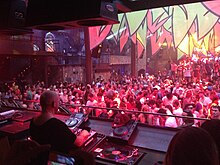 DJ Sven Väth mixes tracks for a crowd of dancers at Amnesia, an Ibiza nightclub, in 2013. | |
| General Information | |
|---|---|
| Location | Worldwide |
| Types of street rave dance | |
| Events | |
| Topics | |
| Origin | |
| History |
|
| Part of a series on |
| Anthropology of nature, science, and technology |
|---|
| Social and cultural anthropology |
A rave (from the verb: to rave) is a dance party at a warehouse, club, or other public or private venue, typically featuring performances by DJs playing electronic dance music. The style is most associated with the early 1990s dance music scene when DJs played at illegal events in musical styles dominated by electronic dance music from a wide range of sub-genres, including drum and bass, dubstep, trap, break, happy hardcore, trance, techno,[1] hardcore, house,[1] and alternative dance. Occasionally live musicians have been known to perform at raves, in addition to other types of performance artists such as go-go dancers and fire dancers. The music is amplified with a large, powerful sound reinforcement system, typically with large subwoofers to produce a deep bass sound. The music is often accompanied by laser light shows, projected coloured images, visual effects and fog machines.
While some raves may be small parties held at nightclubs or private homes, some raves have grown to immense size, such as the large festivals and events featuring multiple DJs and dance areas (e.g., the Castlemorton Common Festival in 1992). Some electronic dance music festivals have features of raves, but on a larger, often commercial scale. Raves may last for a long time, with some events continuing for twenty-four hours, and lasting all through the night. Law enforcement raids and anti-rave laws have presented a challenge to the rave scene in many countries.[2] This is due to the association of rave culture with illegal drugs such as MDMA[3][4] (often referred to as a "club drug" or "party drug" along with MDA[5]), amphetamine, LSD,[3][4] GHB,[3][4] ketamine,[3][4][6] methamphetamine,[3][4] cocaine,[4] and cannabis.[7] In addition to drugs, raves often make use of non-authorized, secret venues, such as squat parties at unoccupied homes,[8] unused warehouses,[9] or aircraft hangars.[10][11] These concerns are often attributed to a type of moral panic surrounding rave culture.[12]
- ^ a b "How rave music conquered America". The Guardian. 2 August 2012.
- ^ Shepherd, John (2003). Continuum Encyclopedia of Popular Music of the World: Performance and production. Volume II. A&C Black. pp. 334–335. ISBN 978-0826463210. Retrieved 10 September 2016.
- ^ a b c d e "Club Drugs". drugabuse.gov. North Bethesda, Maryland: National Institute on Drug Abuse. 2021. Retrieved 17 August 2021.
- ^ a b c d e f Palamar, J. J.; Griffin-Tomas, M.; Ompad, D. C. (2015). "Illicit Drug Use among Rave Attendees in a Nationally Representative Sample of US High School Seniors". Drug and Alcohol Dependence. 152: 24–31. doi:10.1016/j.drugalcdep.2015.05.002. PMC 4458153. PMID 26005041.
- ^ "Cocaine, ethanol and party drug MDA found in Scott Weiland's body". 18 December 2015.
- ^ "Ketamine, better known as the rave drug Special-K, could be our next anti-depressant". 12 May 2016.
- ^ "Marijuana in the Rave Culture of the 90's". 6 February 2018. Archived from the original on 15 March 2019. Retrieved 8 June 2018.
- ^ "Rave & Squat Party Revival". 1 October 2017.
- ^ Rosca, Matei (1 April 2014). "Illegal raves: Social media messages bring in a new generation of partygoers". The Guardian.
- ^ "Illegal raves: How the underground scene has never really gone away". 9 May 2018.
- ^ "The ravers' return: How underground parties are making a comeback". The Independent. 1 May 2016.
- ^ "Italy's right-wing government to criminalise raves". 1 November 2022. Retrieved 8 January 2024.